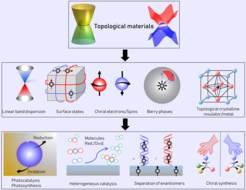Topological Catalysis - X. Wang

Searching efficient and cost-effective catalysts that can replace pure Pt is one of the most important subjects in the area of catalysis. However, in spite of various advanced electrocatalysts have been designed in the last two decades based on nano-engineering such as doping, surface modification, and alloying, the replacement of pure Pt as catalysts is still not achieved.
The observation of fantastic physical properties in topological materials bring us hopes that with these unique phases we can design and synthesis high-efficient catalysts for electrochemical conversion technologies. The band inversion in topological materials leads to numerous favorable physical properties such as robust surface states, extremely high conductivity, and high carrier mobility, which significantly influence the interfacial charge transfer and transport behavior in the catalytic process. In addition, the topological surface states (TSS) can act as both electron acceptors or donators for small adsorbed molecules, consequently tailoring the adsorption energy and Gibbs free energy by choosing a topological phase with a specific electronic structure.
Beside the designing of superior catalysis with the guidance of topology, we are also interest in the understanding of the underlying factors that governing the surface catalysis process. The high-quality bulk single crystal with defined crystal surface can serve as an ideal platform for realizing the interaction between adsorbates and the non-trivial surface states. Our long-term goal is to tune the catalytic reaction pathway by topological materials employing external parameters such as magnetic field and polarized light.


